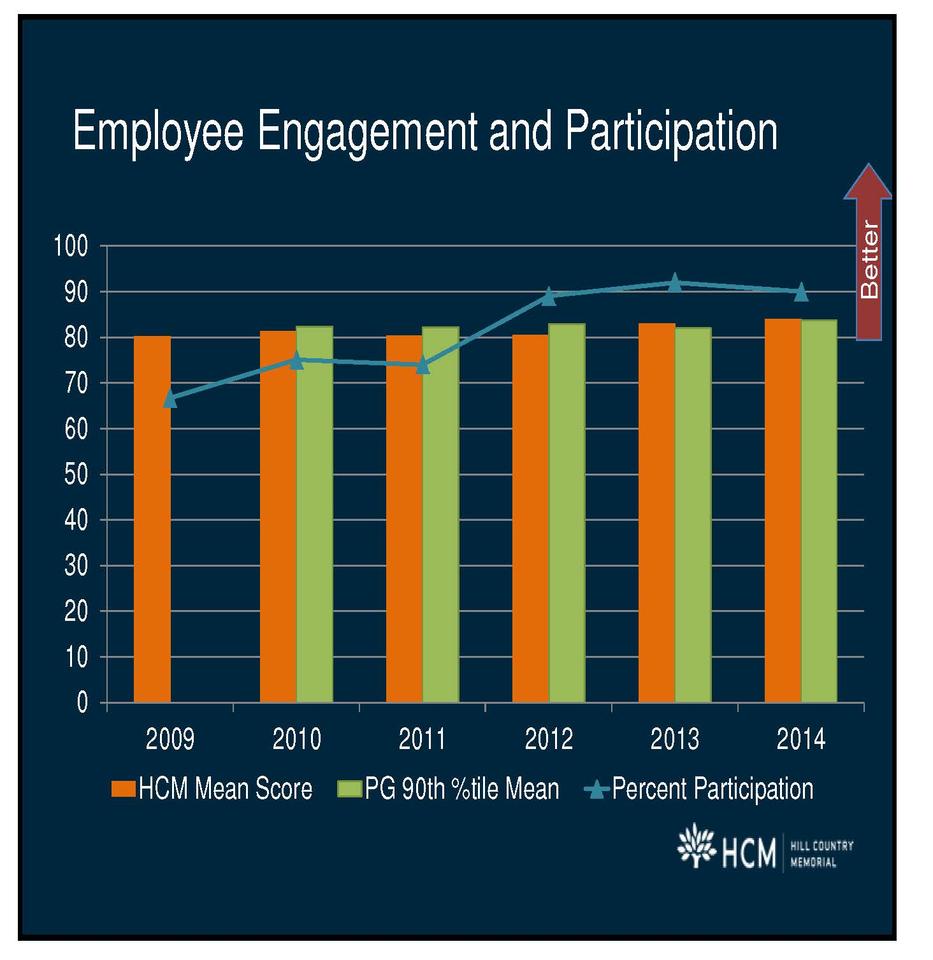Blogrige
The Official Baldrige Blog

“Welcome to remarkable.” That's the first thing new employees at Baldrige Award recipient Hill Country Memorial (HCM) hear at orientation, and that welcome comes personally from CEO Jayne Pope. When staff members of the 86-bed community hospital refer to what is "remarkable," they mean the culture, and when they define "remarkable," they mean in the top 10% of patient care—not for rural hospitals or small, nonprofit hospitals, but for all hospitals in the nation.
In a Quest for Excellence® presentation on HCM's workforce, presenters and panelists shared how they build a "remarkable always" culture by
- hiring a "team of champions," with each team member's personal values in absolute alignment with the organization's values (“If we don’t have the right people in place, we can’t do what we need to do for the people we serve,” said Amanda Stevens, executive director, Hill Country Memorial Hospital Foundation.)
- aligning each team member's goals with the organizational strategy map and departmental goals
- maintaining a performance management system with quarterly coaching plans and evaluations based on position competency and demonstration of values
- setting high expectations
- involving front-liners and physicians, as well as other workforce members, in decision making and action plans
- being transparent (all results from the organizational strategy map for that quarter are posted on hospital walls)
HCM's values—others first, compassion, innovation, accountability, and stewardship—are extremely important, said Alysha Metzger, director, human resources, because HCM's “patients truly are our friends, family, and neighbors. They have come to expect a level of care, service, and interaction as such.”
A few years ago, Metzger said, a 31-person team that included multiple levels of leaders, team members, physicians, and community members identified and defined the five values, as well as what it looked like to live those values, and they brought those draft values on a "listening tour" to every department and every shift, as well as to community members.
In addition, HCM defined the minimum expected behaviors for these values to which each and every staff member and vendor could expect to be held, and these included the behaviors that physicians expected for themselves and their peers.
A key component to ensure the expected behaviors for each value is HCM's quarterly coaching plan, which shows alignment between department and individual goals to help staff members align their work to what the organization is trying to accomplish, said Metzger; “[a coaching plan] helps team members see how they're doing their job, and doing it well helps us as a departmental team, which ultimately helps us as an organization. That’s something that is really special.”
The tool is used by supervisors and their designees to give quarterly feedback to staff members on how they are meeting goals and demonstrating the HCM values and performance characteristics. Leaders also receive feedback on how they are demonstrating specific leadership attributes.
The coaching plan also helps team members identify measures of success; if they are not surpassing the goals, then a coach can talk with the staff member about what’s preventing accomplishment of goals.
"The most important thing is creating a dialogue between the leader and team members," said Metzger. "What does the person want to achieve both personally and professionally? Values are incorporated as well. It’s important to give people feedback on whether they are demonstrating behaviors that are in alignment with our values.”
Gina Enderlin, HCM's nurse educator, said because coaching plans allow communication about personal and professional goals, they can be used to prevent physician and nurse burnout. “It’s that personal communication that’s so important," she said. "[Coaching plans] gives us the opportunity to see and to hear where they’re at, to find out what they need and the direction that they want to go.”
John Phelps, director, nutrition services, said the coaching plans were initially not well received because of the perceived level of work on directors, but he said they eventually saw the value of open dialogue with staff. He added that the process got faster and more efficient after staff members realized that they were being coached not counseled.
The coaching plans also help HCM take a proactive stance on turnover, especially for critical positions like nurses, said Enderlin. Quarterly coaching means leaders are in constant communication with team members, including nurses. “Most important is the listening,” she said. “You have to hear, have to really listen to desires and interest. After hearing someone’s personal and professional goals, we can afford them the ability to cross-train, if desired.”
After implementing values-based interviewing and coaching plans, turnover for first-year nurses decreased about 4%, said Metzger.
The quarterly coaching plans are not part of human resources or official performance reviews intentionally, said Metzger, and the success of the coaching plan process can be measured by a specific question on the Press Ganey engagement survey that asks about supervisors providing feedback to help goal achievement.
Physicians and volunteers participate in a similar process to the quarterly coaching plans. Both processes include the strategy of open dialogue and listening, which for physicians is leading to higher engagement. Said James Partin, HCM's chief medical officer, "The biggest issue [for engaging physicians] is communication, communication, communication, and that has to be two-way. Involve [physicians] in the decision-making process. What turns [physicians] off the most is . . . telling them this is what you are going to do without involving them in the process of making the decision.”
Volunteers also participate in open dialogue. According to Phelps, conversations with volunteers yield information on whether they are exhibiting the values, want to increase hours, or might find a better fit elsewhere in the organization.
How might coaching plans work in your organization
About the author
Related Posts
Comments
- Reply





